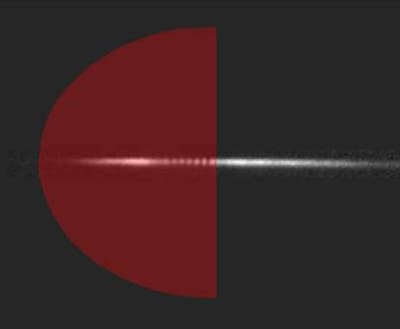
A Bose–Einstein condensate (BEC) of ultracold atoms has been used to create a laboratory analogue of laser emission from a black hole. The work was done by Jeff Steinhauer at Technion in Israel, and could also provide strong evidence for the existence of “Hawking radiation”. However, multiple definitions of this term are in use, and the most theoretically revolutionary type has not been observed.
When astronomical black holes were first proposed, they were thought to be completely dark and featureless. However, in 1974 Stephen Hawking showed that quantum field theory predicts that pairs of photons are created on either side of a black-hole event horizon – the point at which even light cannot escape the gravitational pull of the black hole. The photon inside the horizon carries “negative energy” and falls in. The other photon, which carries positive energy, escapes. Therefore, black holes should emit radiation.
Such a proposal is astounding, explains James Anglin of the University of Kaiserslautern in Germany, because it suggests that black holes behave as black bodies with well-defined temperatures. Hawking also showed that, in space–time geometry, black holes can be entirely defined by three properties. These two results seem to imply that the founding principles of thermodynamics, in which temperature is defined as the average energy in a large number of degrees of freedom, need revision. “It was very hard to imagine how something that only had three numbers to its name could possibly have a temperature,” explains Anglin. “It was a matter of potentially redefining thermodynamics by bringing it together with general relativity and quantum mechanics – and that made everybody really excited!” The catch, however, is that the “temperature” of all known black holes would be lower than the cosmic-microwave-background temperature, making the radiation effectively undetectable.
Flowing fluids
In 1981 William Unruh of the University of British Columbia showed that the equations predicting Hawking radiation should also apply to sound waves in fluid flow. Now, Jeff Steinhauer has used a BEC to simulate a black hole with two horizons – the main event horizon and a second “inner horizon”. In cosmology, this could occur if the black hole was either rotating or charged. The photons falling into the black hole would be unable to cross the inner horizon and so would reflect back towards the event horizon – although this is a controversial suggestion because they would have to travel faster than the speed of light to do so.
Unable to escape the event horizon, the photons would bounce between the two horizons, thus forming a standing wave. As they bounced back and forth, their energy would become increasingly negative. To preserve the total energy at zero, positive energy would be emitted outside the event horizon in the form of light at a single frequency and an ever-increasing intensity, forming a “black-hole laser”.
Steinhauer’s simulation of this scenario relies on the fact that for relatively long-wavelength waves, the speed of sound in a BEC is less than 1 mm s–1. Sound with short wavelengths, however, can travel faster than this speed. He confined the BEC – rubidium atoms chilled to well below a temperature of 1 K so they are all in the same quantum state – in a long tube using a focused laser beam. The BEC is then allowed to flow in one direction and the flow rate is controlled such that, in a specified region of the tube, the condensate travels faster than the local speed of sound, while on either side of this region the flow rate is subsonic.
Supersonic region
In the supersonic region, only sound waves of very short wavelength can propagate against the flow, creating negative-energy modes that are unable to exit the supersonic region. These modes bounce back and forth, creating a standing-wave pattern in the BEC that gradually increases in amplitude. On one side of the supersonic region, low-frequency sound waves are emitted, and the amplitude of these gradually increases. According to Steinhauer, these waves are analogous to the radiation produced outside the event horizon of a black hole. Although the system is not a real black hole, the experiment “shows that the Hawking mechanism works”, explains Steinhaeuer. “If the same mechanism works in one system, it should probably work in the other system too,” he says.
Renaud Parentani, an expert on black-hole analogue systems at Université de Paris-Sud, is impressed. “Observing the lasing effect is an indirect – but almost direct – observation of the Hawking effect,” he explains, “because the latter is necessary for the lasing to take place.”
However, Steinhauer’s model would lead to an unstable, exploding black hole, rather than the steadily radiating black body predicted by Hawking. Anglin is hopeful that further experiments could either reproduce Hawking’s black-body radiation or provide important insights into why it cannot be simulated. “In that sense, this is one of the biggest advances in Hawking-radiation studies that there has been since the beginning,” he says.
The research is published in Nature Physics.



